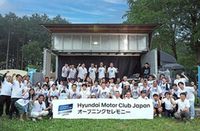On August 8, 2025, two automotive giants—Hyundai Motor Company and General Motors (GM)—unveiled an ambitious joint development plan set to reshape the landscape of the global car industry. The move, which centers on the co-development of mid-size SUVs and pickup trucks, comes at a time when international trade tensions and shifting consumer demands are putting unprecedented pressure on automakers to innovate and collaborate.
According to HanKyung.com, the partnership will see GM developing mid-size pickup platforms, while Hyundai focuses on small passenger cars, SUVs, pickup trucks, and electric commercial vans. Both companies plan to share these platforms, adding distinctive exteriors and interiors before launching new models in various overseas markets. The collaboration extends beyond product development, encompassing joint procurement of raw materials and auto parts, shared logistics, and even the co-development of carbon-reducing steel—a nod to the growing importance of sustainability in the automotive sector.
The rationale behind this alliance is crystal clear: cost reduction and profit protection. Since April 2025, both Hyundai and GM have suffered significant financial setbacks due to steep U.S. import tariffs. Hyundai’s operating profit alone dropped by 828.2 billion KRW in the second quarter, while GM was hit with tariff costs totaling nearly 1.5 trillion KRW. Although the tariff rate was lowered to 15% this month, neither company can fully pass these costs onto consumers, inevitably eroding their profit margins. Faced with these challenges, the two automakers are pooling resources to drive down development and procurement expenses, hoping to shield their bottom lines from further damage.
This isn’t merely a tactical response to tariffs. As HanKyung.com points out, the overlap between Hyundai and GM’s core product lines is minimal, allowing both to maximize the benefits of the partnership without cannibalizing each other’s sales. Industry observers believe this alliance could set a precedent for future collaborations among global automakers, as the sector faces mounting threats from low-cost Chinese electric vehicle (EV) manufacturers and an increasingly volatile market.
Indeed, the automotive world has already seen a flurry of similar partnerships. Ford and Volkswagen, GM and Honda, and Japanese giants Toyota, Subaru, and Mazda have all embarked on platform-sharing ventures. Just last month, Honda and Nissan—Japan’s second and third largest automakers—announced plans to standardize their software platforms for software-defined vehicles (SDVs), underscoring the industry’s urgent need for scale and efficiency.
Hyundai and GM’s latest joint venture goes further, with plans to accelerate cooperation not just in North America, but also in Japan and Europe. Their Japanese joint venture has recently expanded its focus to include the development of small SUV platforms, highlighting both companies’ commitment to broadening their product portfolios and strengthening their foothold in key international markets.
Production capacity is another major focus. Since April, Hyundai has ramped up its North American manufacturing by 25% and invested a staggering 8.282 trillion KRW in GM-related production facilities in the United States. This brings Hyundai’s total investment in the region to about 1.75 trillion KRW. The goal? To increase production capacity by 15%. However, given uncertain market conditions, it remains to be seen whether these facilities will reach full capacity utilization in the near term.
But the story doesn’t end with boardroom deals and factory expansions. On August 3, 2025, Hyundai Motor Japan marked a milestone in its global strategy by officially launching the Hyundai Motor Club Japan, the automaker’s first overseas fan club, in Fuchu, Japan. The two-day event, held at the picturesque TREE LINE chillax field near Mount Fuji, brought together Japanese and Korean Hyundai enthusiasts, company representatives, and members of the original Hyundai Motor Club Korea.
According to NBN News, Hyundai Motor Club Korea was founded in 2015 as a community for Hyundai owners and fans. Today, it boasts over 122,000 members worldwide who share automotive information and everyday experiences, both online and offline. The club has even formed its own amateur racing team, TEAM HMC, and engages in regular social contribution activities.
The launch event in Japan featured a variety of programs designed to foster camaraderie among Hyundai fans from both countries. Attendees swapped stories about their experiences driving Hyundai EVs, discussed the unique joys of EV life, and explored ways to further promote Hyundai’s electric vehicles in Japan. The event also provided an opportunity to share best practices from the Korean fan club, helping to lay the groundwork for Hyundai Motor Club Japan’s future growth.
Toshiyuki Shimegi, head of Hyundai Motor Japan, welcomed the new club members with optimism. “We expect the members of Hyundai Motor Club Japan to become the driving force behind Hyundai’s EV growth in Japan,” he said. “Through the EV lifestyle with Hyundai, we hope that owners around the world can appreciate the value of Hyundai EVs.”
Hyundai’s push into Japan is part of a broader strategy to expand EV sales and boost brand recognition, both domestically and internationally. Since entering the Japanese passenger car market in May 2022, the company has steadily increased its EV sales and worked to raise awareness of its brand among Japanese consumers. The launch of Hyundai Motor Club Japan is expected to help the automaker better understand local customer needs and further spread the Hyundai brand experience.
Fan club activities go beyond brand promotion. They provide a valuable feedback loop, allowing Hyundai to tap directly into the insights and preferences of its most passionate customers. As the club grows, it will play a critical role in supporting EV owners, sharing practical information, and fostering a sense of community among Hyundai enthusiasts in Japan and beyond.
Meanwhile, Hyundai’s expansion of production capacity and parts supply is expected to continue as part of its ongoing cooperation with GM. The companies’ joint efforts in North America and Central America—including original equipment manufacturing, parts production, and supply chain optimization—are designed to maximize efficiency and competitiveness in a rapidly evolving market.
With the automotive industry facing headwinds from trade disputes, technological disruption, and fierce competition from new entrants, the Hyundai-GM alliance stands out as a bold experiment in collaborative innovation. If successful, it could serve as a model for other automakers navigating the choppy waters of the 21st-century global economy.
For now, all eyes are on Hyundai and GM as they chart a new course—one that blends technical cooperation, community engagement, and a relentless drive for efficiency. Whether this alliance will deliver the hoped-for profits and market share remains to be seen, but it’s already clear that the rules of the game are changing, and these two industry heavyweights are determined not to be left behind.




